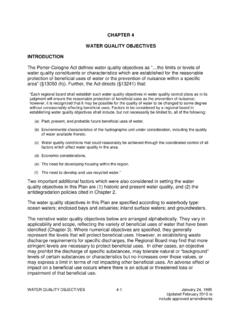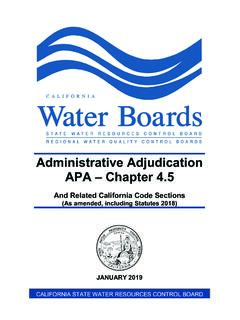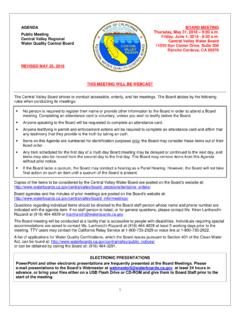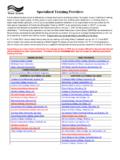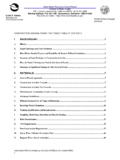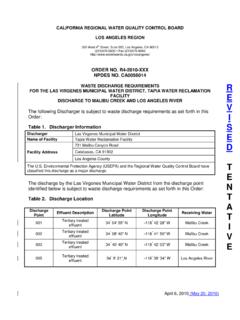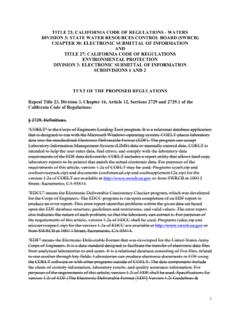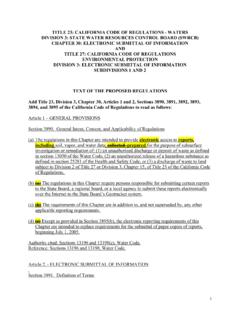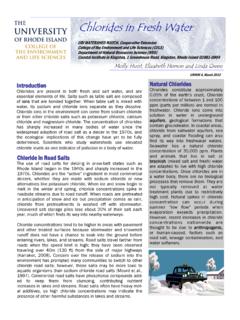Transcription of Electrical Conductivity/Salinity Fact Sheet
1 Fact Sheet The Clean water Team Guidance Compendium for Watershed Monitoring and Assessment State water Resources Control Board (EC)V2e 4/27/2004 Page 1 Electrical Conductivity/Salinity Fact Sheet What is Electrical Conductivity/Salinity /TDS? Solids can be found in nature in a dissolved form. Salts that dissolve in water break into positively and negatively charged ions. conductivity is the ability of water to conduct an Electrical current, and the dissolved ions are the conductors.
2 The major positively charged ions are sodium, (Na+) calcium (Ca+2), potassium (K+) and magnesium (Mg+2). The major negatively charged ions are chloride (Cl-), sulfate (SO4-2), carbonate (CO3-2), and bicarbonate (HCO3-). Nitrates (NO3-2) and phosphates (PO4-3) are minor contributors to conductivity , although they are very important biologically. Salinity is a measure of the amount of salts in the water . Because dissolved ions increase salinity as well as conductivity , the two measures are related. The salts in sea water are primarily sodium chloride (NaCl).
3 However, other saline waters, such as Mono Lake, owe their high salinity to a combination of dissolved ions including sodium, chloride, carbonate and sulfate. Why is it Important? Salts and other substances affect the quality of water used for irrigation or drinking. They also have a critical influence on aquatic biota, and every kind of organism has a typical salinity range that it can tolerate. Moreover, the ionic composition of the water can be critical. For example, cladocerans ( water fleas) are far more sensitive to potassium chloride than sodium chloride at the same concentration.
4 conductivity will vary with water source: ground water , water drained from agricultural fields, municipal waste water , rainfall. Therefore, conductivity can indicate groundwater seepage or a sewage leak. How is it Measured? conductivity is measured by a probe, which applies voltage between two electrodes. The drop in voltage is used to measure the resistance of the water , which is then converted to conductivity . conductivity is reciprocal to resistance and is measured in the amount of conductance over a certain distance.
5 The conductivity unit has been called mho because it is the inverse of ohm , the resistance unit. The basic unit is "mho/cm", otherwise known as 1 Siemen. However, this unit does not Fact Sheet really occur in water and we are using one thousandth (mili-) or one millionths (micro-) of it for natural waters (1000 milimhos and 1,000,000 micromhos are equal to one mho). The useful unit for seawater is milimhos/cm (mS); ocean waters are around 55 mS. The useful unit for freshwater is micromhos/cm (umhos/cm, or uS); tap water ranges between 50 and 800 uS (depending on the source).
6 Because Electrical conductivity greatly depends on temperature, scientists use the term specific conductivity if the value has been corrected to reflect the measurement temperature (see for more detail about temperature and conductivity ). Salinity can be measured using a hydrometer or a refractometer. The hydrometer measures specific gravity which can then be converted to salinity. The refractometer measures the ability of the water to refract light. Scientists also measure salinity by determining the amount of chlorine in seawater.
7 Salinity can also be measured gravimetrically ( , as the weight of the total dissolved solids per a given volume of water ). The results are usually expressed in grams/liter (g/l) or parts per thousand (ppt) for sea water (Pacific Ocean water are around 32 g/l in winter). In freshwater the term total dissolved solids (TDS) is often used for the same thing instead of salinity . Useful TDS units are milligrams/liter (mg/l) or parts per million (ppm). See for more detail about the relationship between the different methods.
8 What Affects it in water ? 1. Rain! In pristine environments, rainwater conductivity equals zero ( , the rain is essentially distilled water ). Rain falling into a waterbody, or rain runoff flowing into it, will decrease Conductivity/Salinity . 2. Minerals: Soil and rocks release ions into the waters that flow through or over them. The geology of a certain area will determine the amount and type of ions. Spring water typically shows higher conductivity than inland rain water . 3. Ocean Spray: The salinity/ conductivity of coastal rivers is influenced by sea spray that can carry salts into the air, which then fall back into the rivers with rainfall.
9 4. Tides and mixing zones: In flat areas, water at the river mouths are often salty because of salt water intrusion during high tides. The flow of rivers into estuaries can greatly affect salinity as well as the location of the estuarine mixing zone. This is very important to the survival of estuarine organisms. 5. Evaporation: Evaporation and loss of fresh water will increase the conductivity and salinity of a waterbody. Warm weather can even increase ocean salinity. The Clean water Team Guidance Compendium for Watershed Monitoring and Assessment State water Resources Control Board, Division of water Quality July 2002 Page 2 Fact Sheet What are the Typical Ranges?
10 conductivity of water water Type conductivity (umhos/cm) Distilled water - Melted snow 2 - 42 Potable water in 30 - 1500 Freshwater streams 100-2000 The table above shows some ranges of conductivity values you might encounter in the field. conductivity can be much higher than the maximum values shown above under special conditions in some waters, for examples: rivers or drainage ditches dominated by subsurface agricultural return flows, ephemeral streams or pools late in the season, tidally influenced coastal waters, and naturally saline or brackish lakes or ponds The salinity of some naturally saline waters is indicated in the following table.
